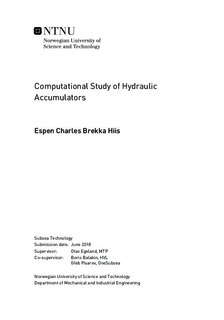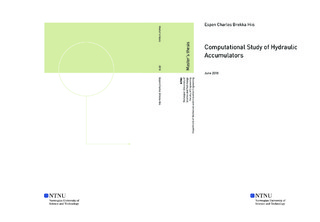| dc.description.abstract | The scope of this project is to make a CFD model to be used for getting a better
understanding of accumulator discharge. To be able to establish the models credibility is
there a need for validation of the models developed. First a model of one accumulator is
to be validated by use of an experimental project as well as an analytical approach. This
model is then to be adapted to a system of two accumulators in series to be studied and
validated by a theoretical equation developed.
The literature review reveal that the study of accumulator discharge for applications
for the oil industry is not a area were many articles is presented, which makes the scope of
this thesis more interesting.
The first case studied is a single bladder-type accumulator, which is discharged through
three different outlet areas and has an internal volume of 4 l, with a pre-charge pressure of
2 bar. The physical model developed is validated by experimental data, and a theoretical
approach to establish the models credibility. The average discrepancies obtained from
the results was below 12.56% for all cases modeled. These results shows a high level
of agreement to the various validation points, which leads to significant credibility of the
physical model developed. This model is then to be adapted to the following cases in this
study.
The second case studies discharge of a set of two 40 l accumulators placed in series
with different pre-charge pressures, but equal charge pressure. The case studies the effect
of changing the ambient temperature, outlet area of the discharge nozzle, and different outlet
pressures (backpressure). The obtained results shows that the effect of various ambient
temperature will not have a significant impact on the discharge pattern, but by changing the
restrictions in the outlet nozzle the profiles obtained showed great deviation from the base
case computation. Where the variation of outlet area of the nozzle had a bigger impact
on the discharge than by changing the backpressure in the system. An observation from
this case shows that the pressure drop in the accumulator with the lowest pre-charge had a
rapid pressure drop in the first part of the discharge cycle. This pressure drop is caused by
the flow pattern out of the given accumulator.
The last case studied is a similar case as the one above, but with accumulator volumes
of 10 l each. In this case the effect of changing the pre-charge order, as well as
the backpressure was studied. The results obtained from this study shows that changing
the pre-charge order will provide a more constant pressure delivery without a rapid pressure
drop in the system. This will result in a more stable and predictable flow out of the
hydraulic system studied. Even when changing the restrictions in the outlet nozzle, the
results shows a more stable flow out of the system, with similar pressure profiles. | |

